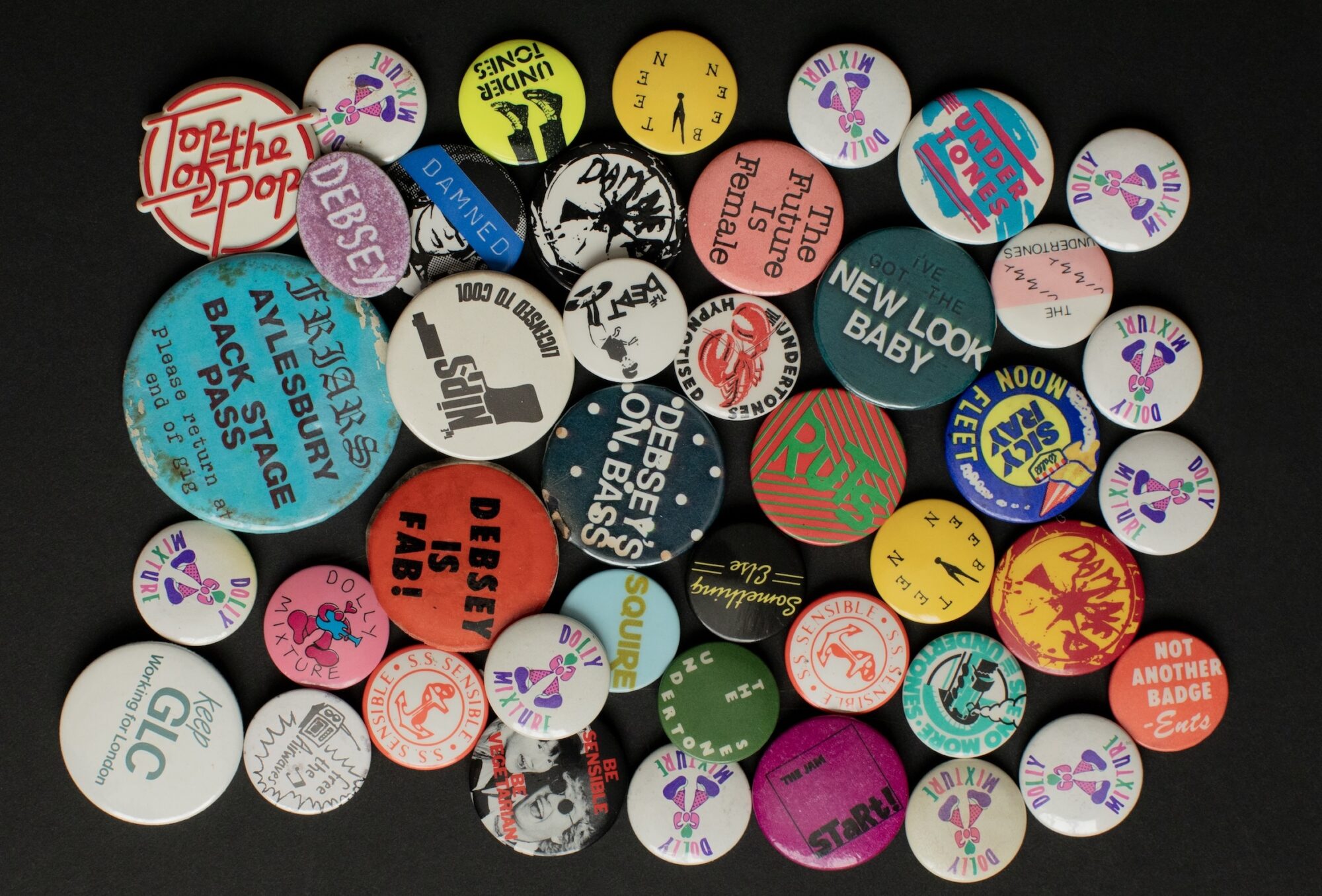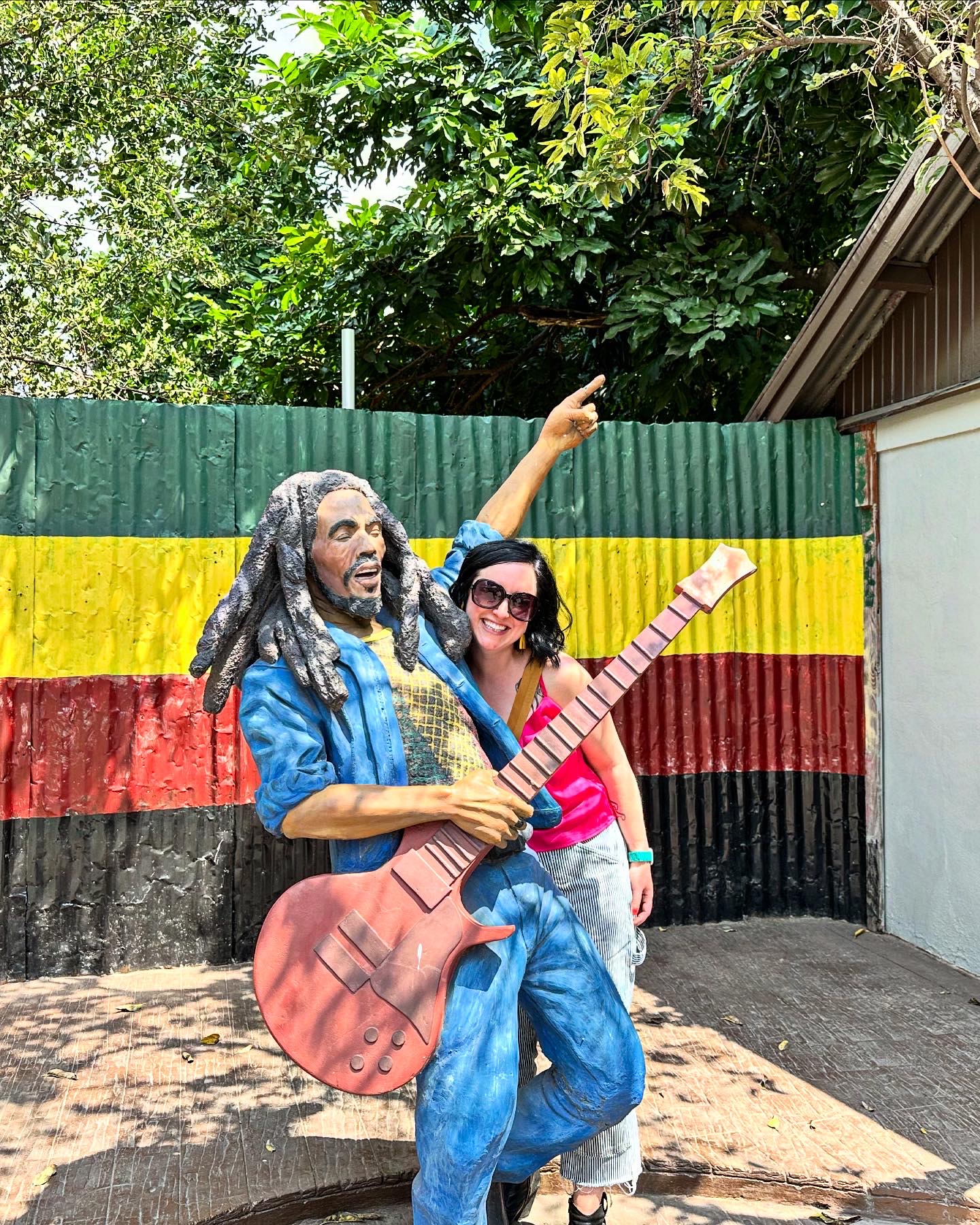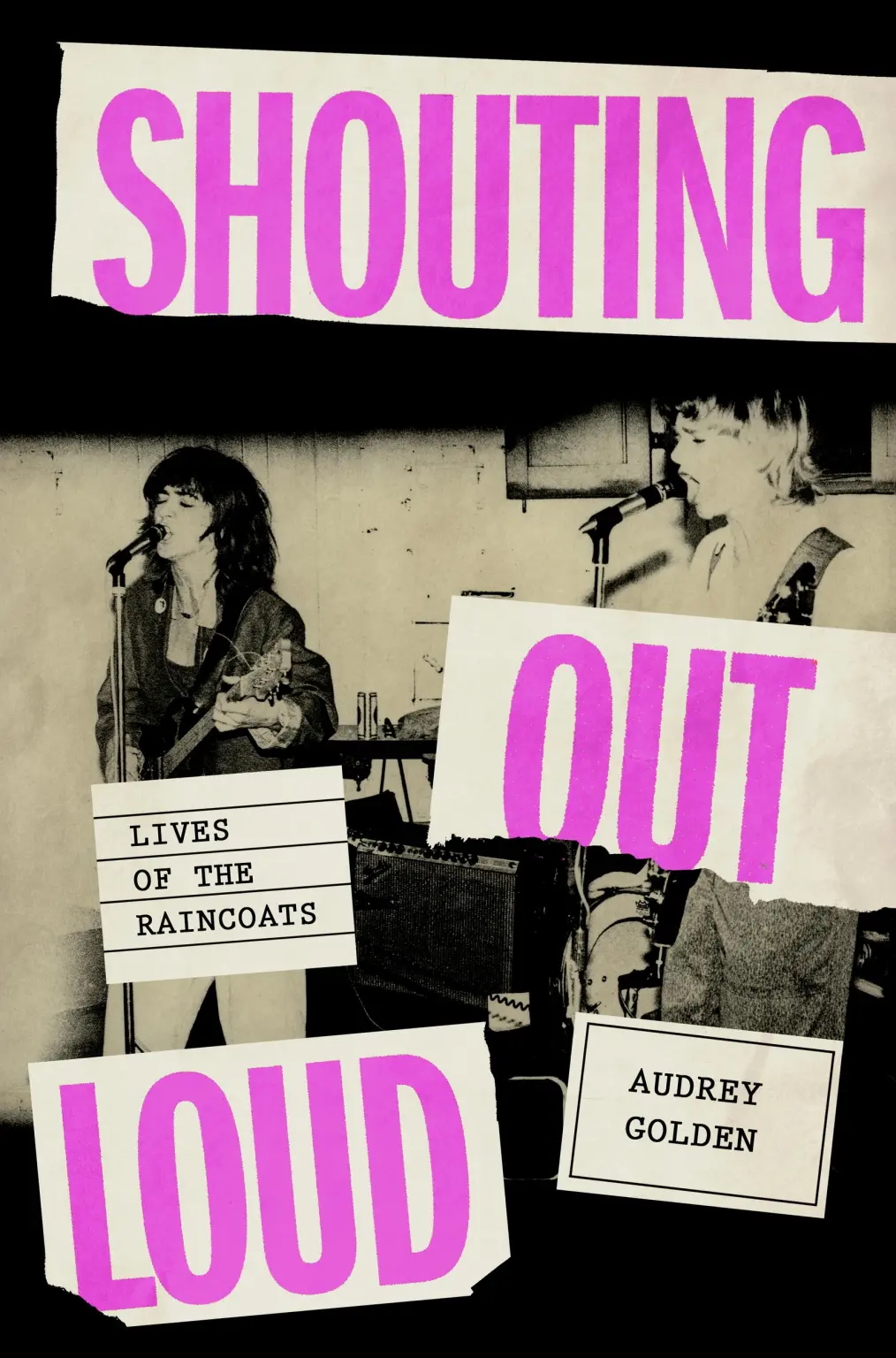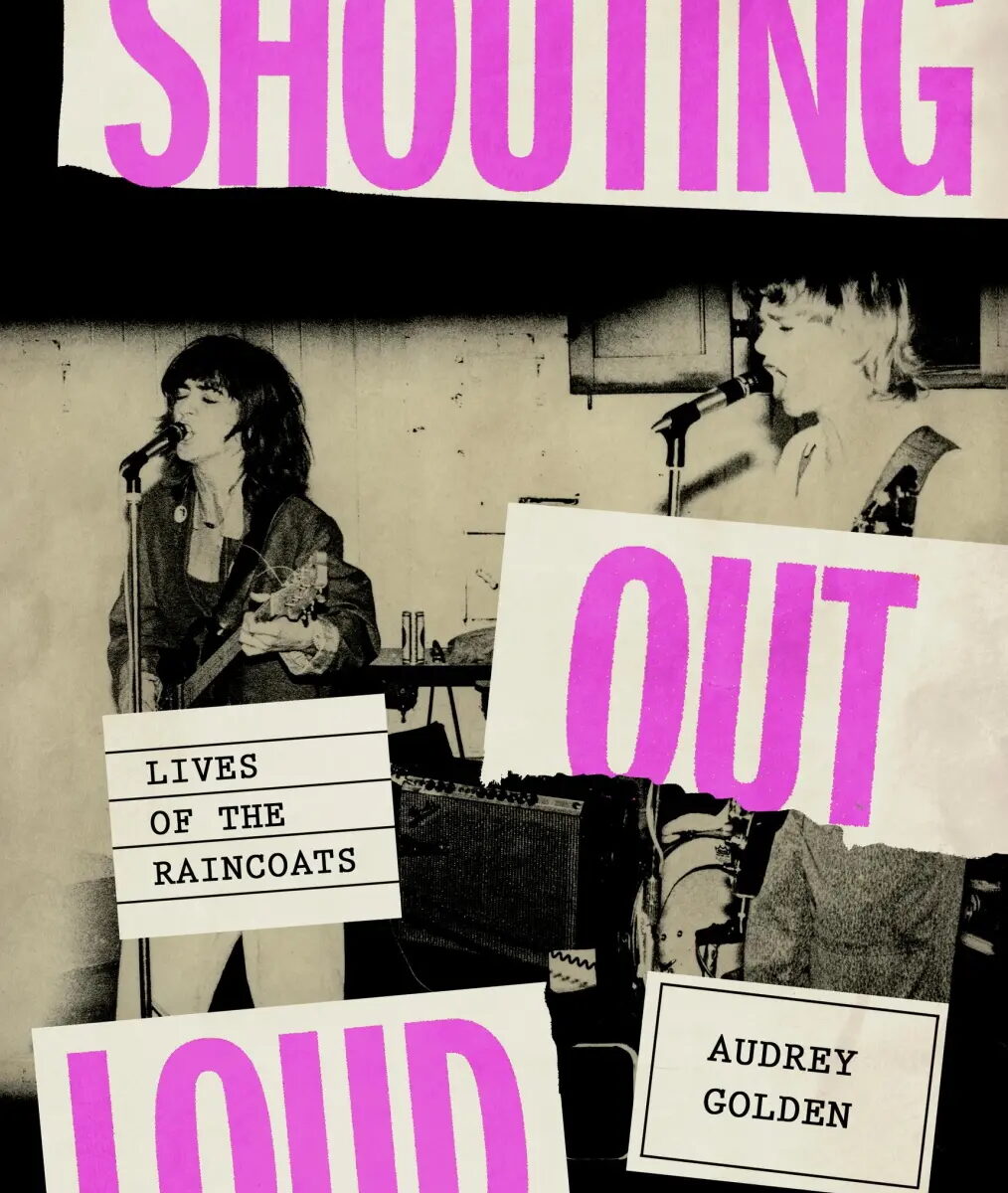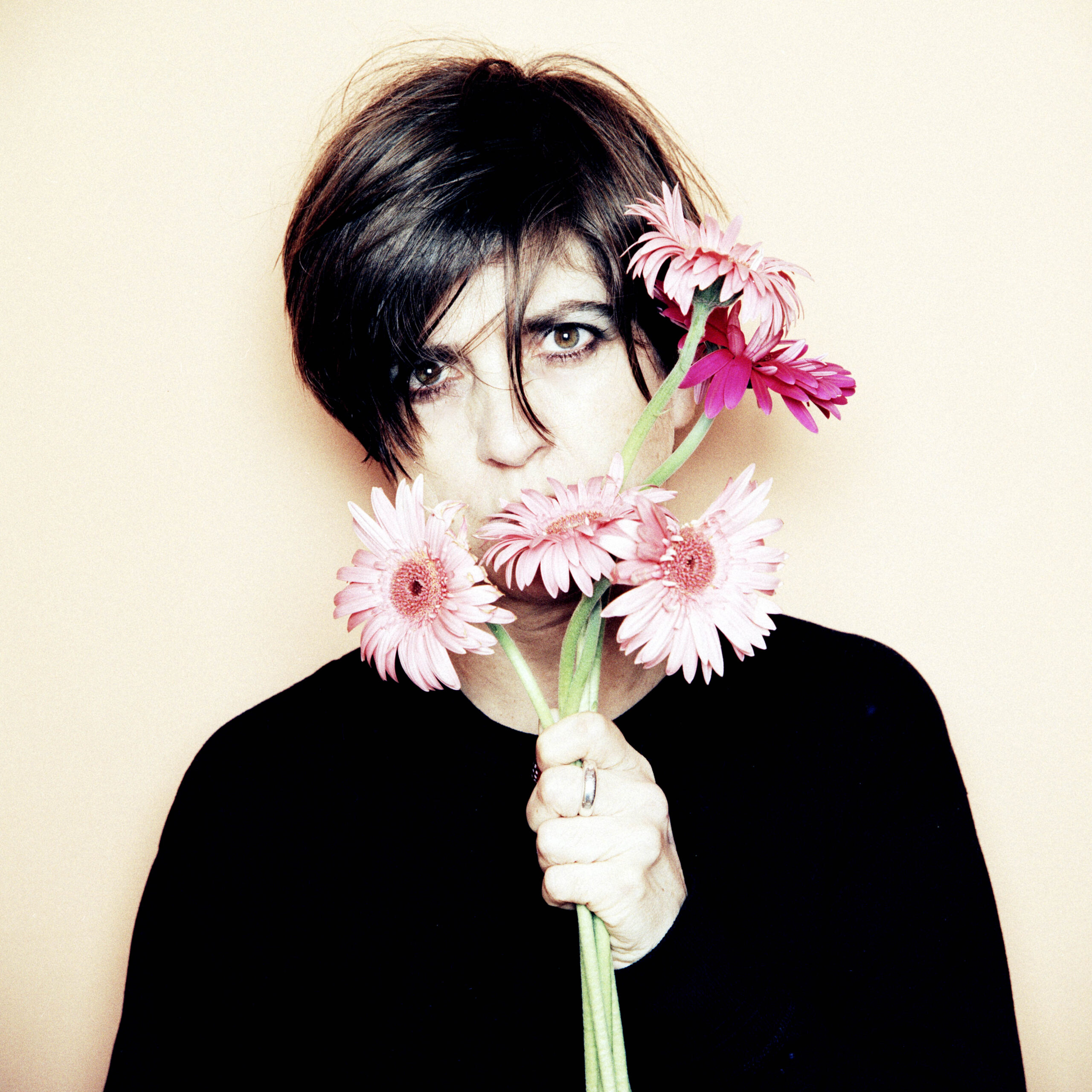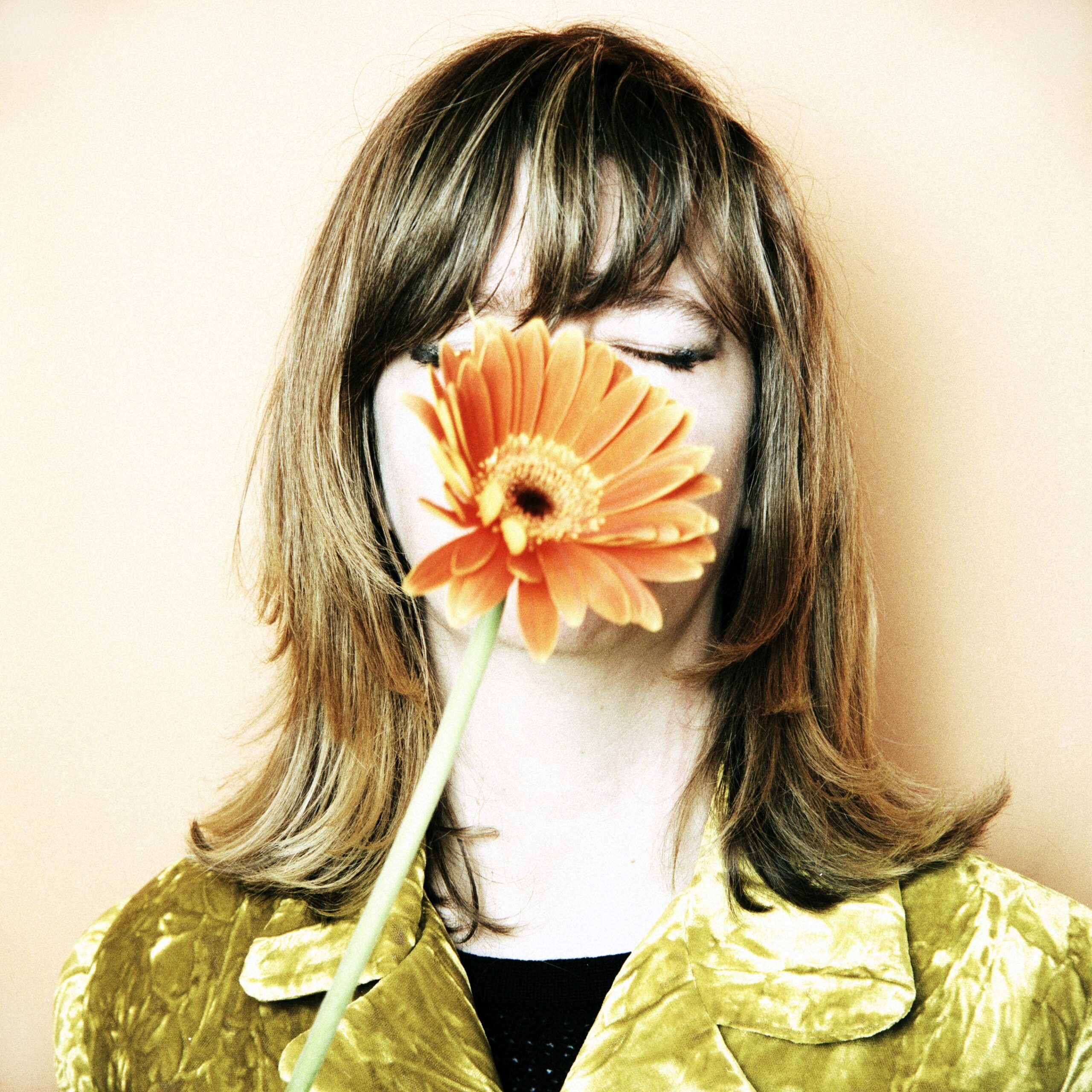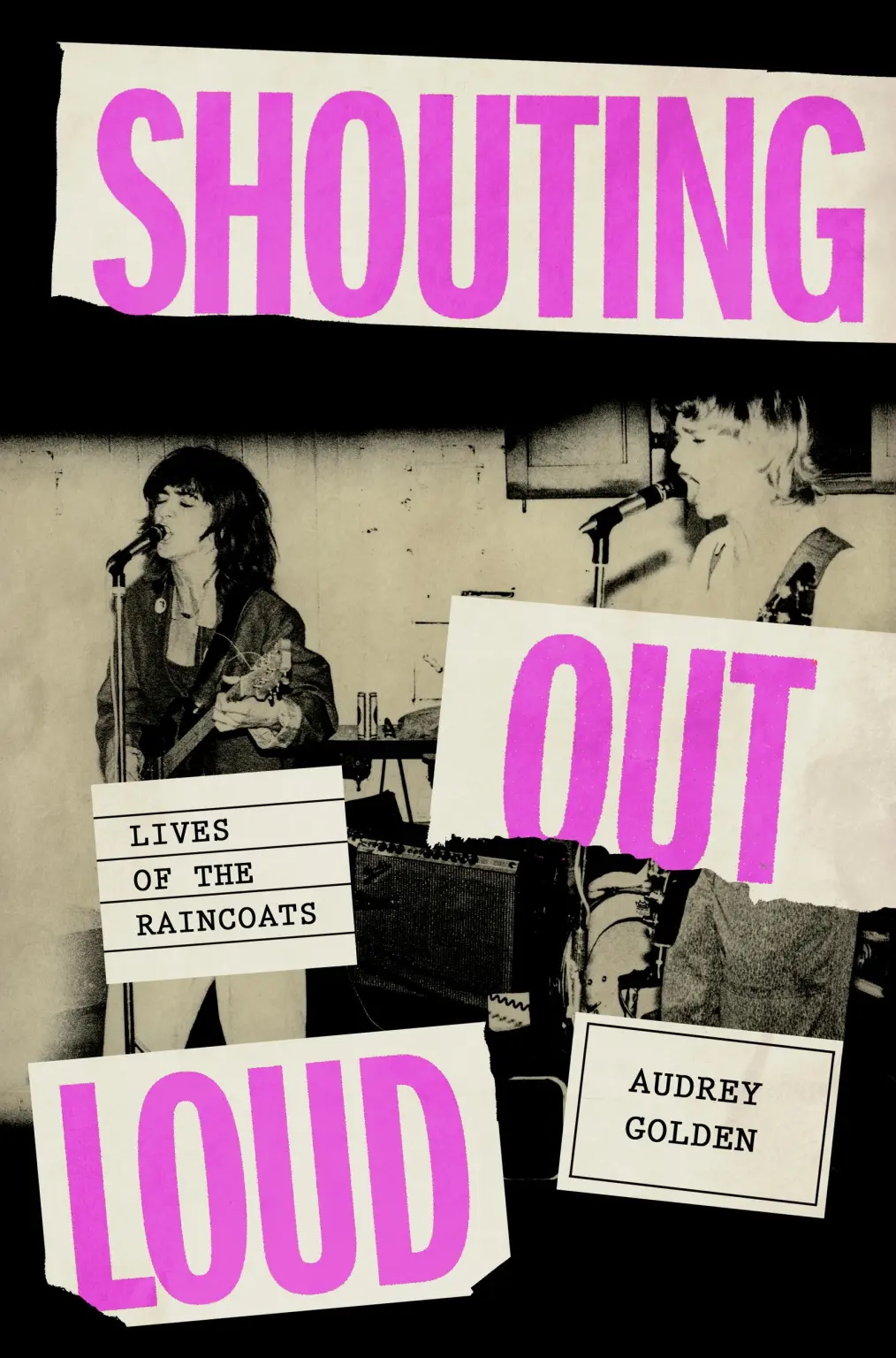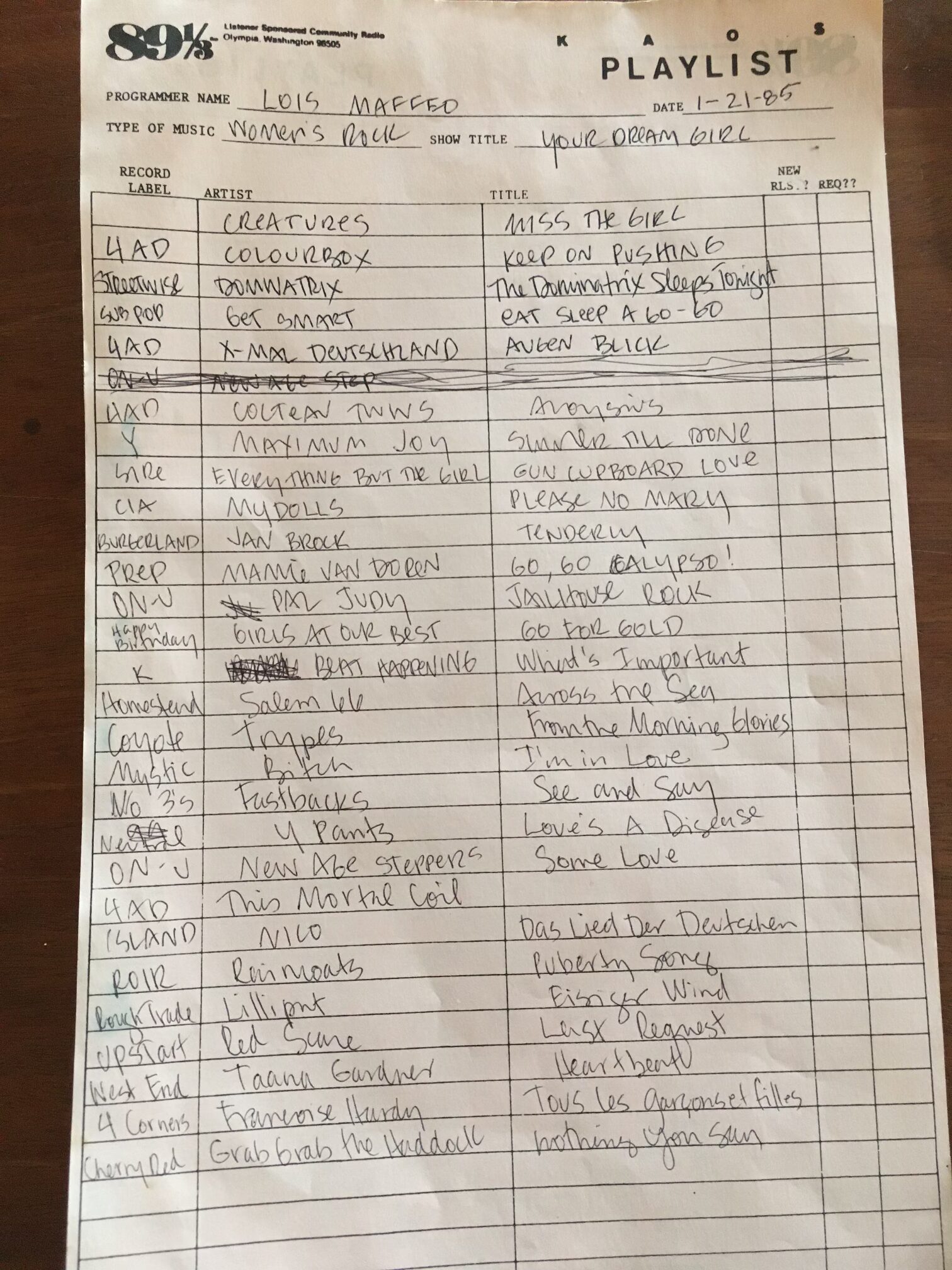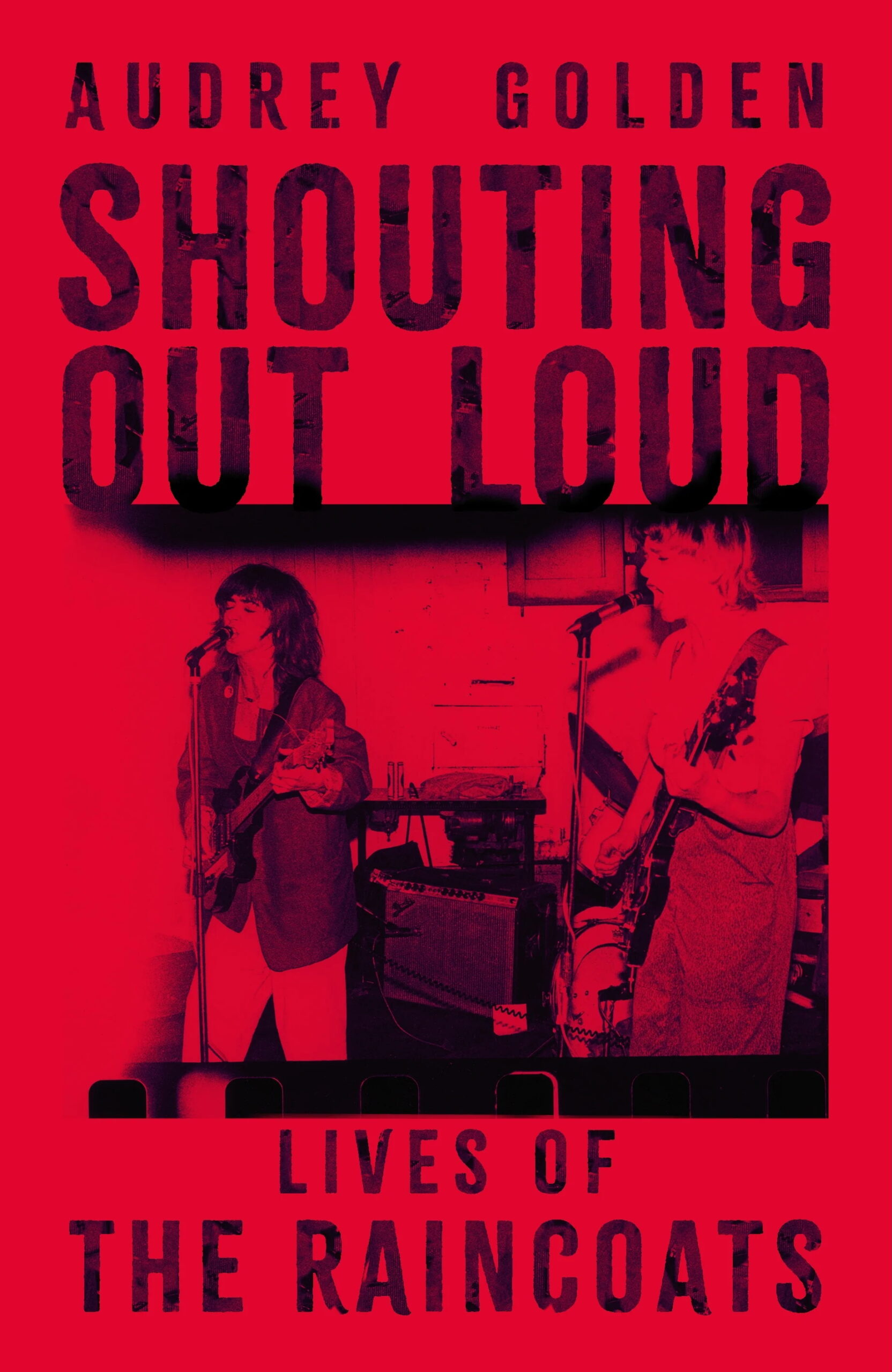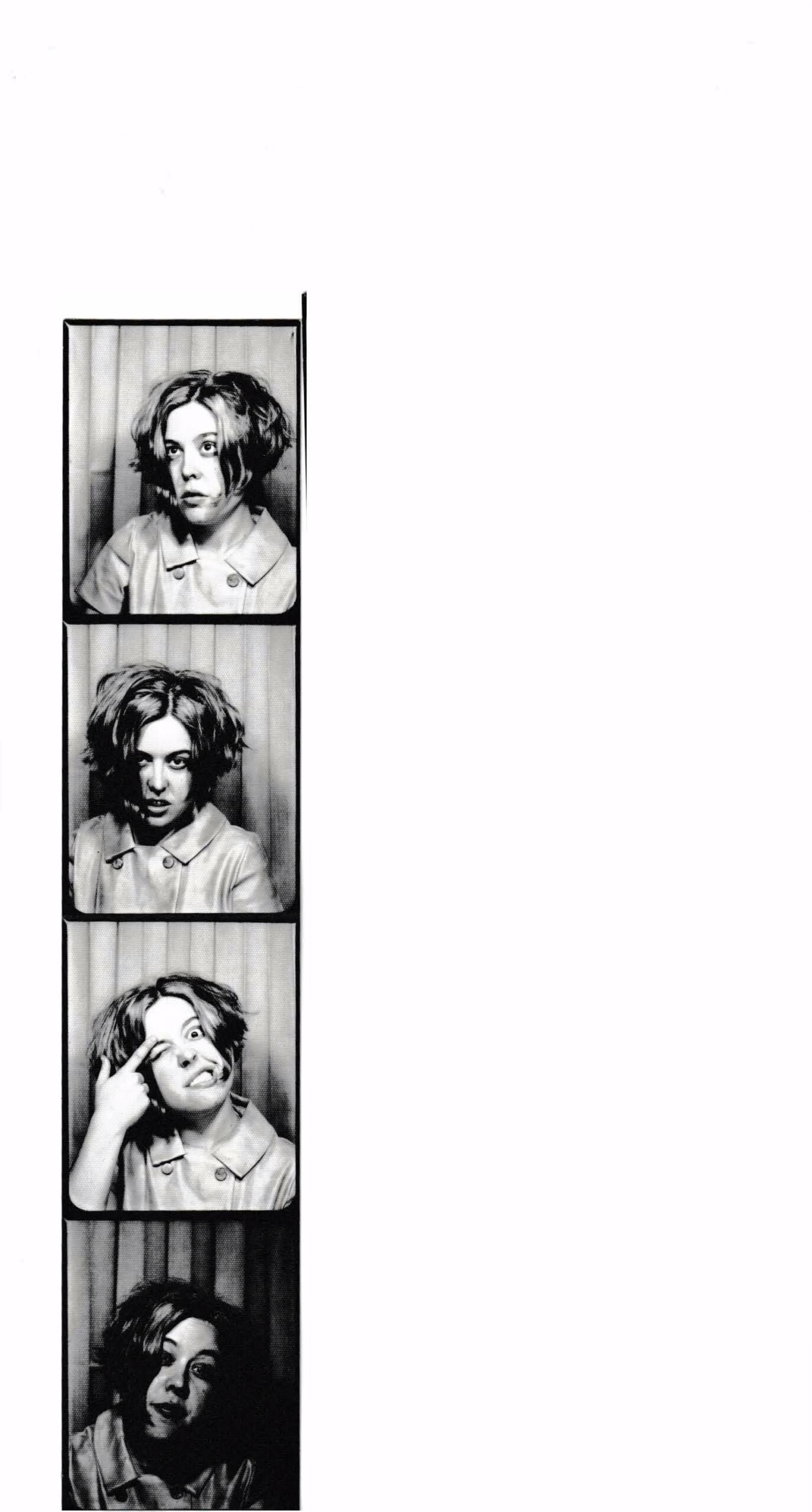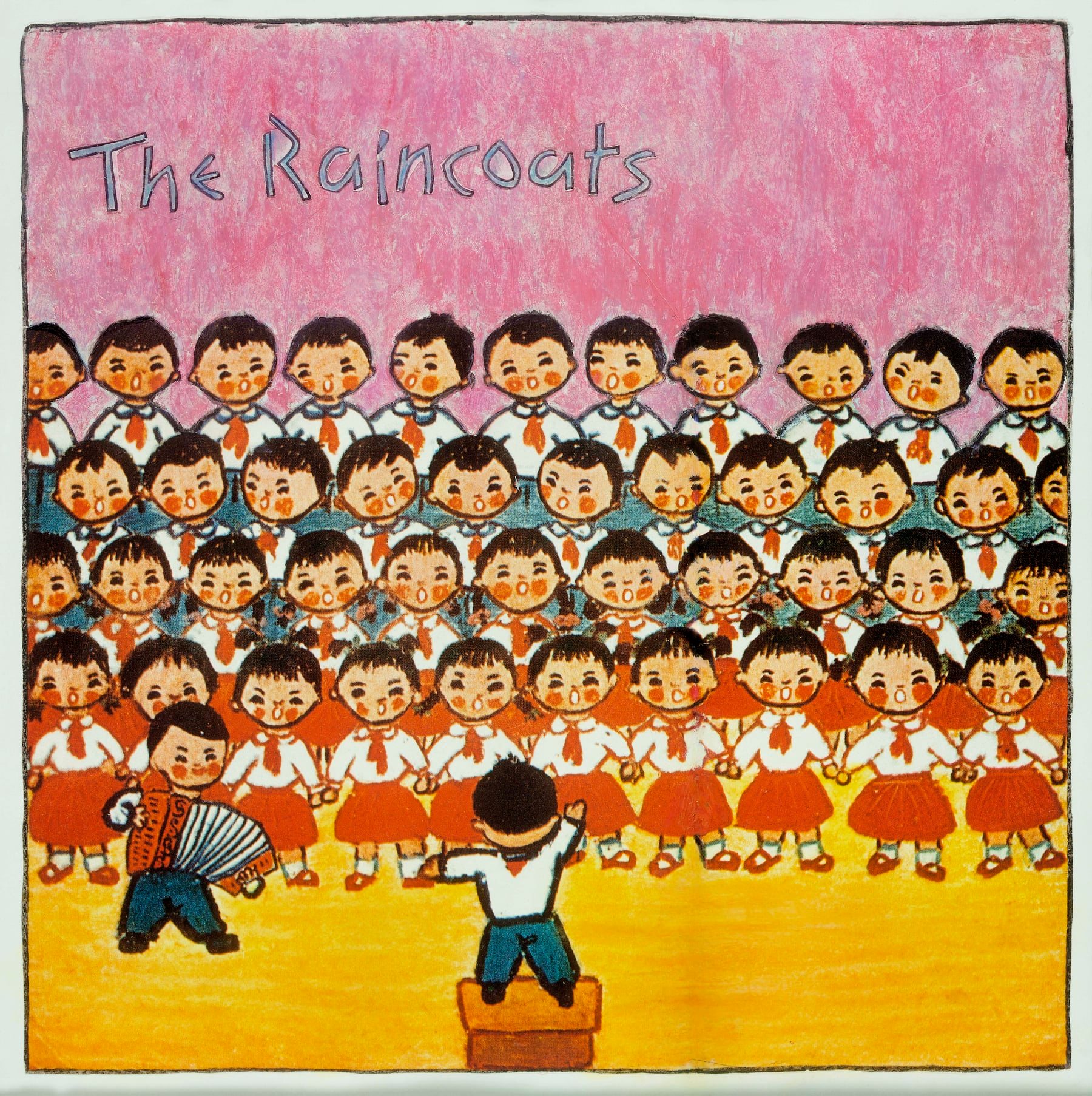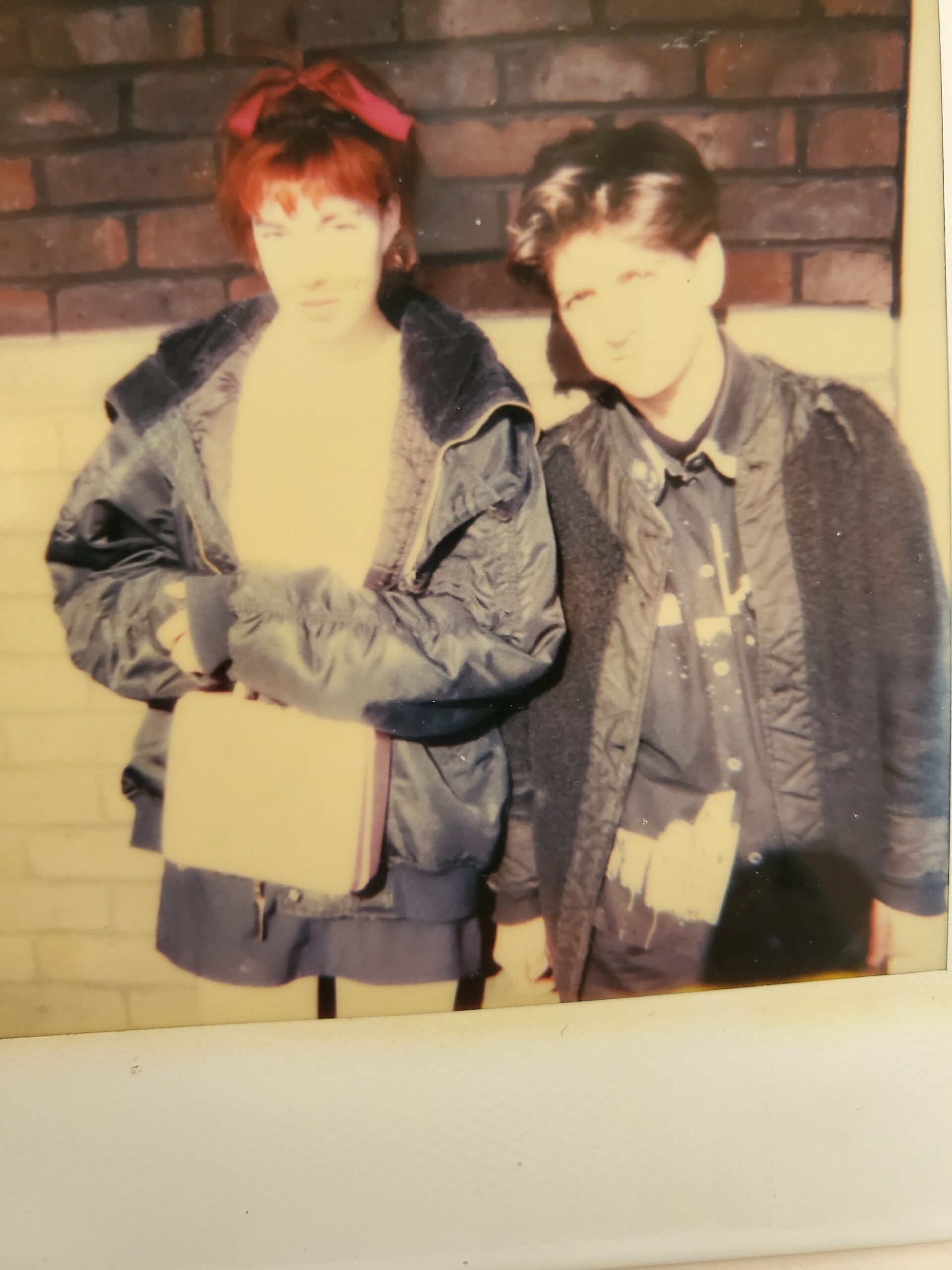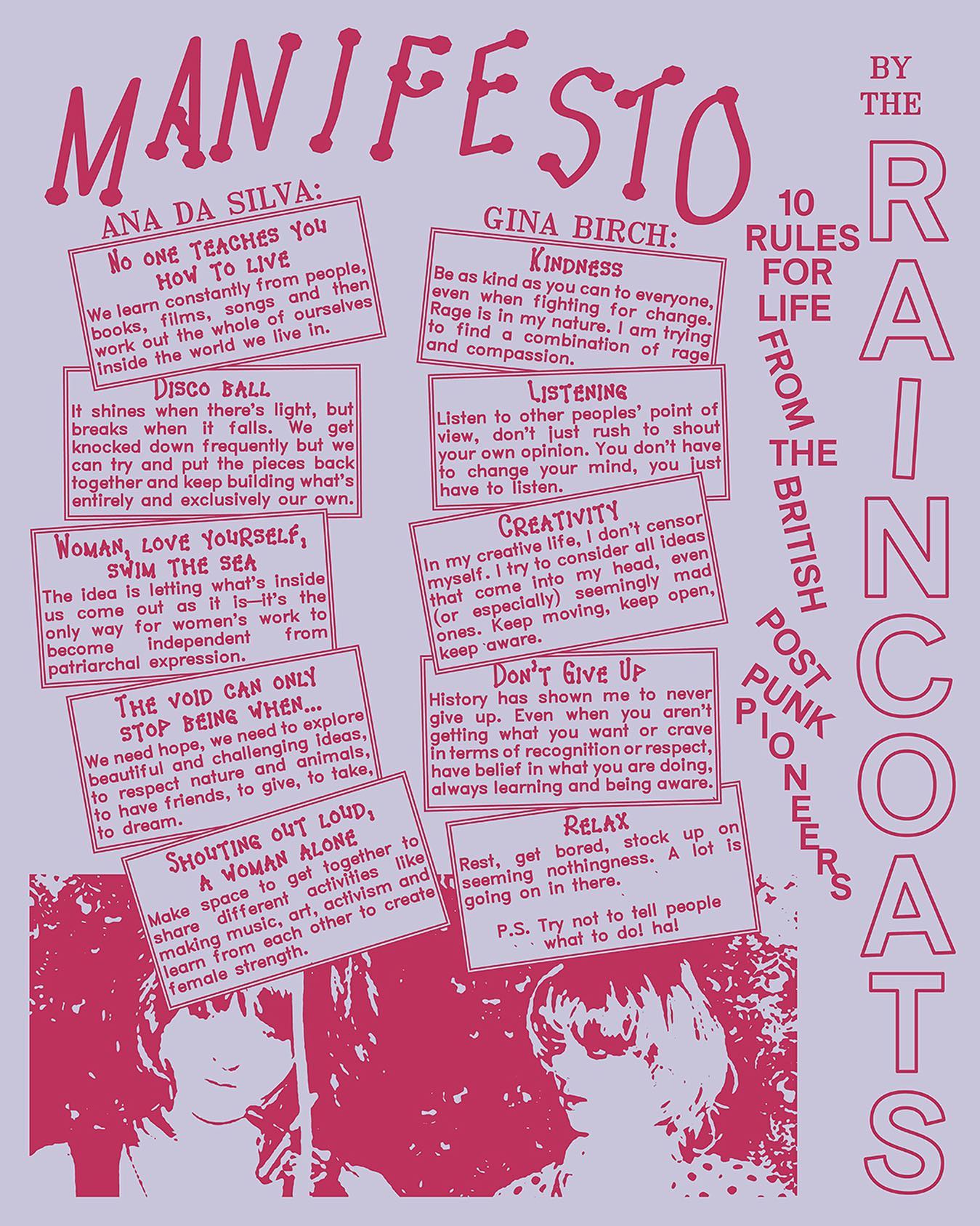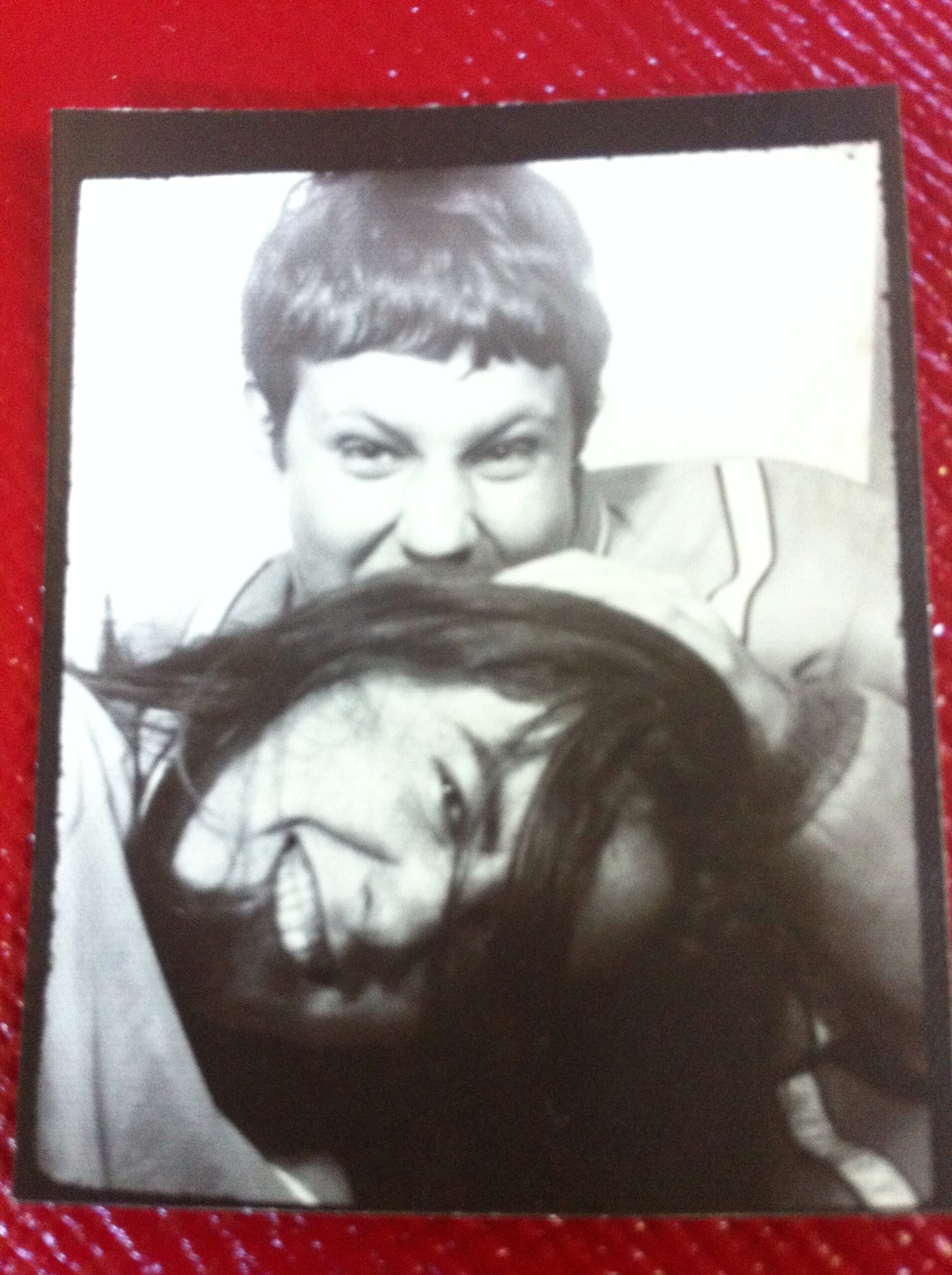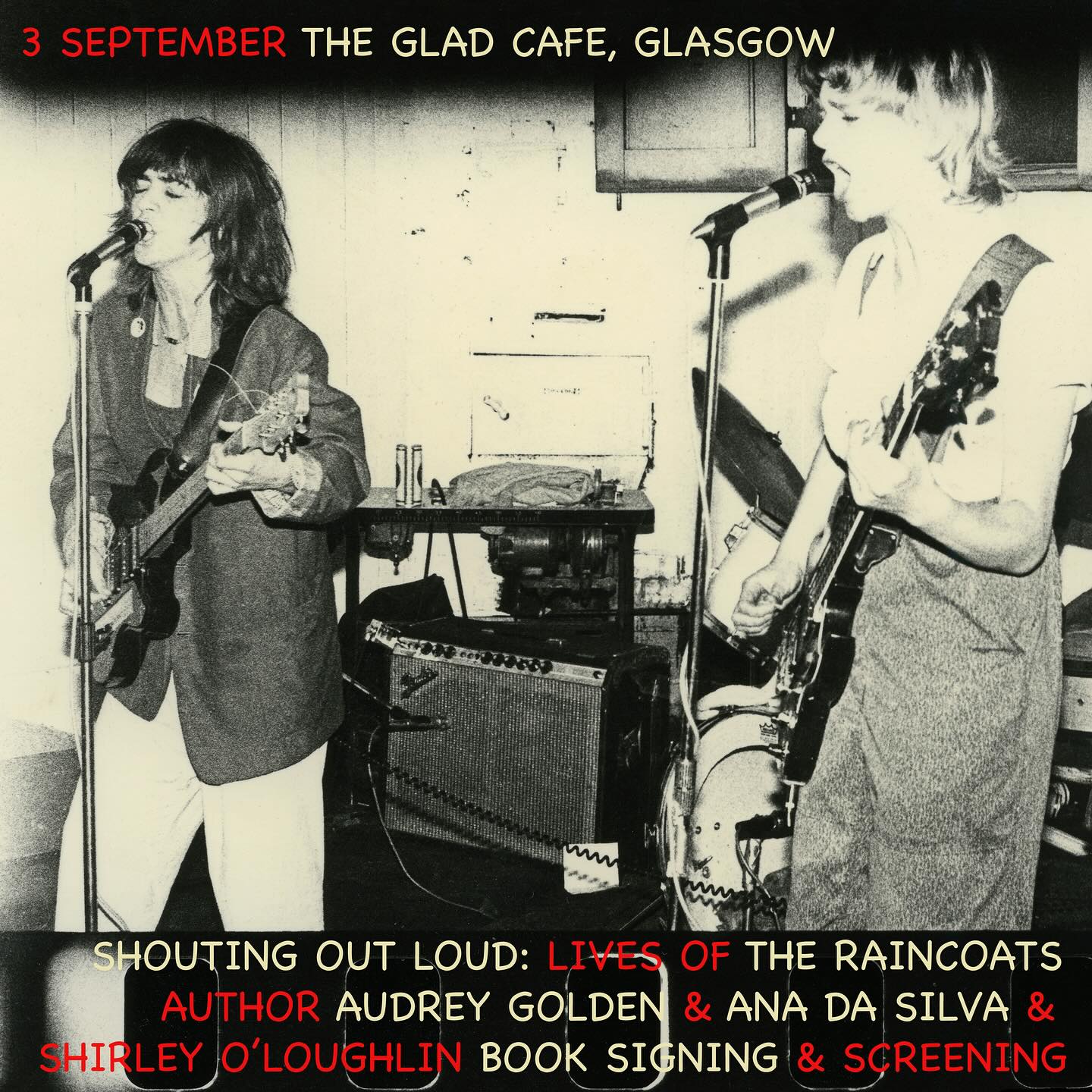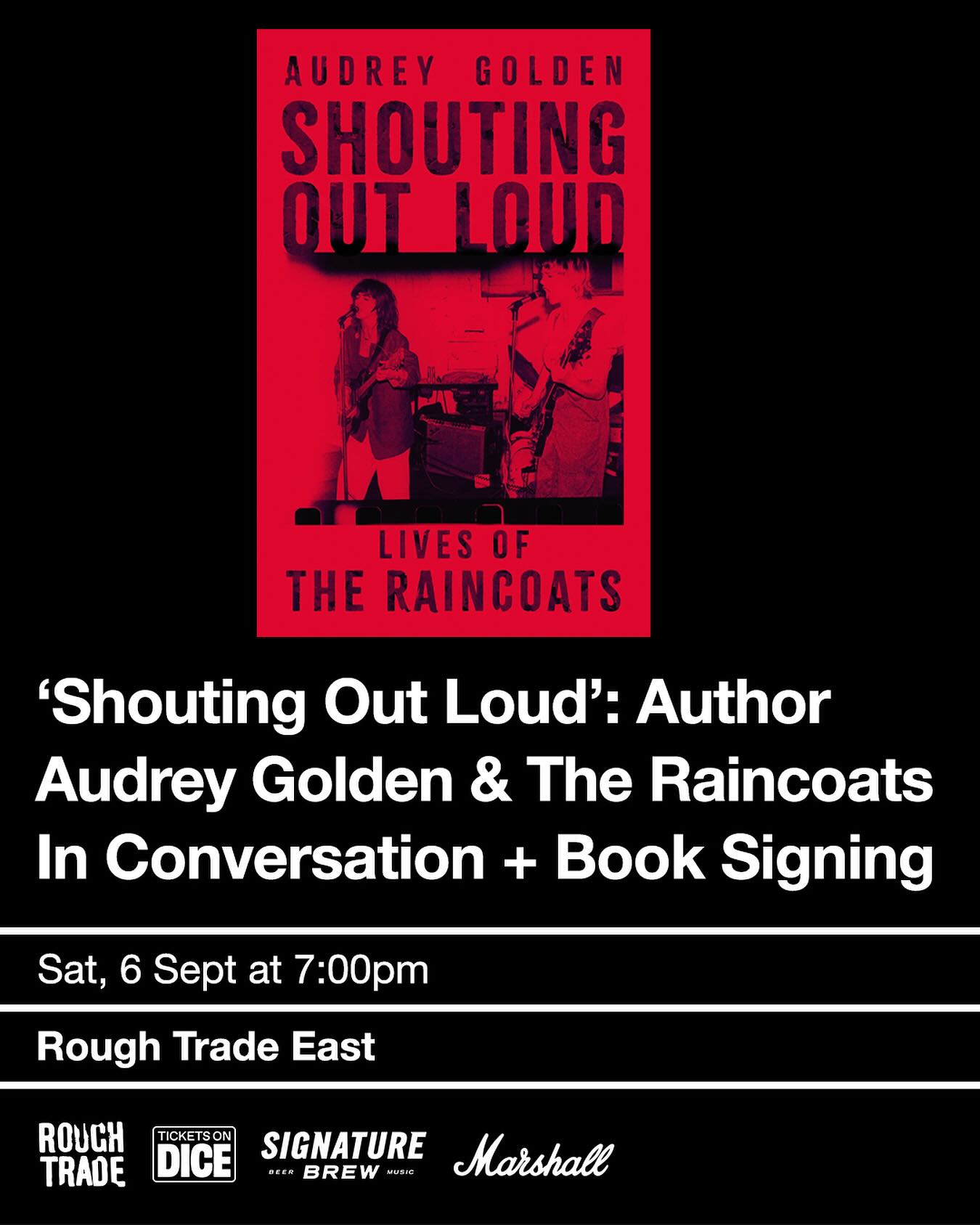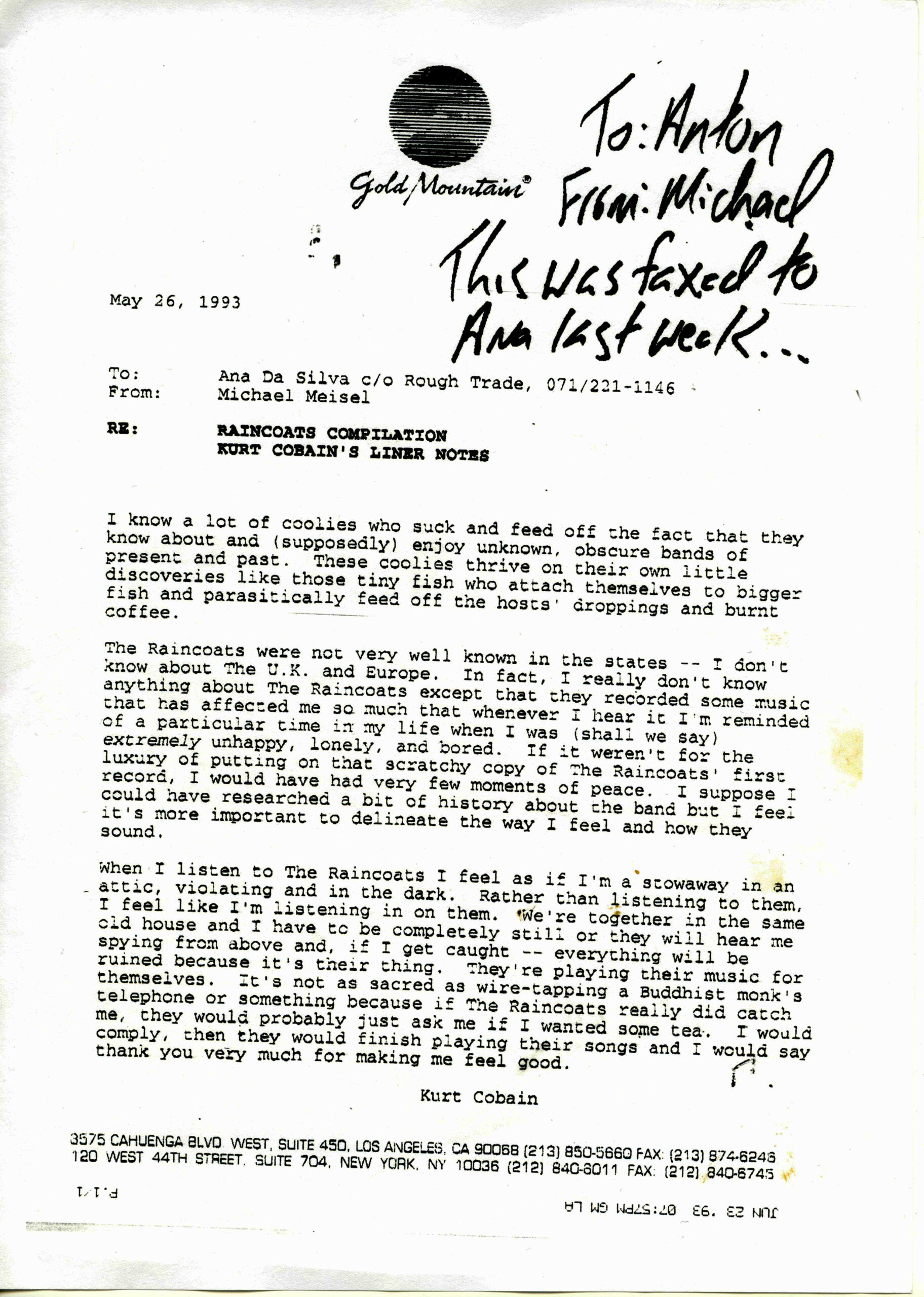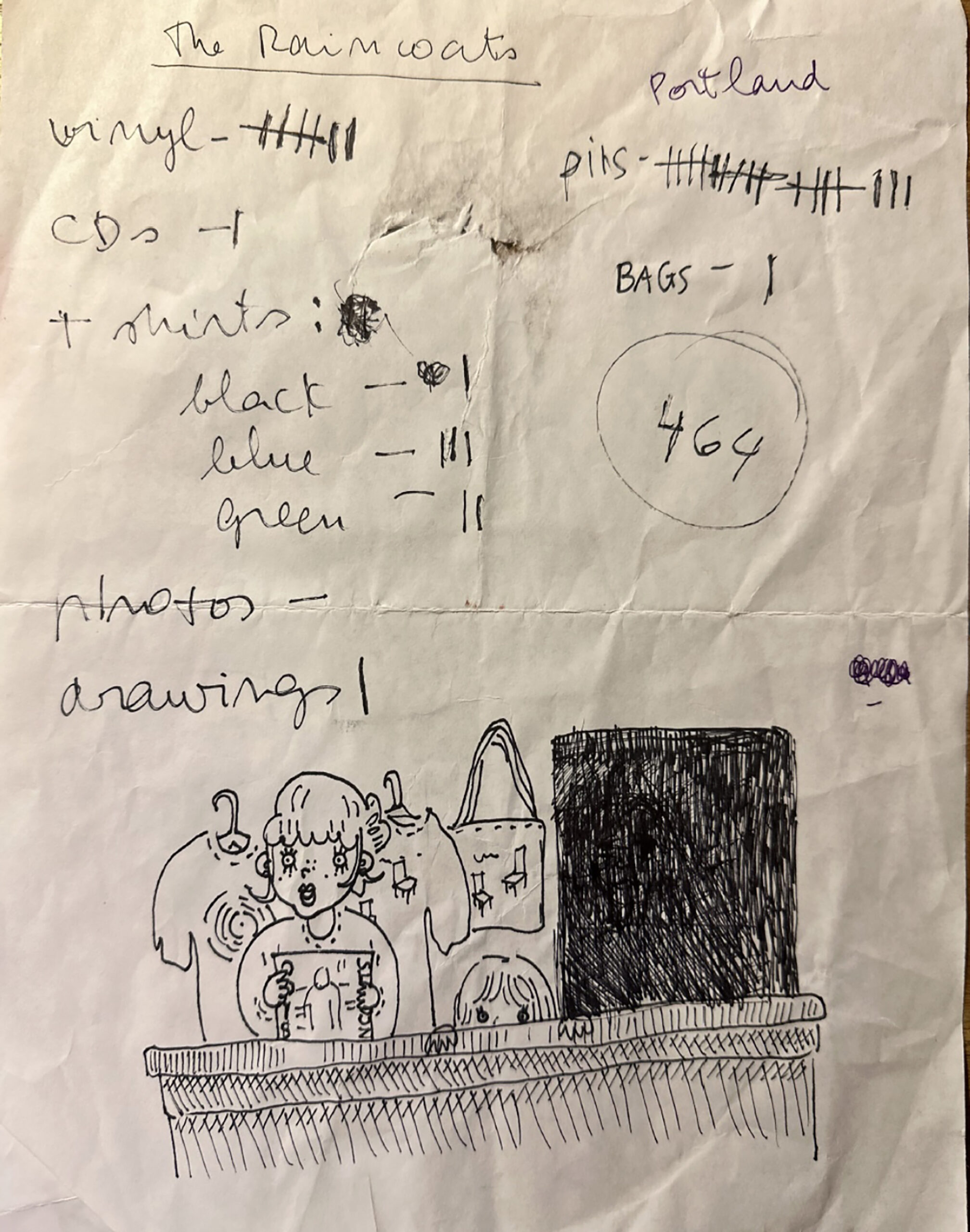
Just a few days before the U.S. publication date of Shouting Out Loud: Lives of the Raincoats, we caught up with the New York writer-editor-journalist and cat mom Audrey Golden to ask about her process, the music she loves and her life. She also wrote the great oral history I Thought I Heard You Speak: Women at Factory Records, which finally unearthed the stories from the women behind the famed Manchester label. Scroll all the way down to see where some upcoming book events are and read our excerpt as well. (Photographs courtesy of Audrey Golden)
READ: Our excerpt from Shouting Out Loud
chickfactor: What are you up to today?
Audrey Golden: I’m listening to a new Lung Leg song that’ll be out in October, and I LOVE it. It’s so powerful, and so fun and cathartic to sing along to. I’m writing a piece about them and the music scene in Glasgow, and I’m trying to finish that up today.
I’m getting ready for the publication of and a lot of upcoming book events for Shouting Out Loud! I’m getting ready to head to Seattle and Portland next week (for events on July 17 and 18), then some events on the east coast (Rough Trade NYC on July 25 and Mass MoCA on July 31) before I head to Europe, where I’ll be joined by The Raincoats for events. Since the book is out really soon, I’ve also been doing interviews and some publicity for it. I’m so excited for it to finally get into readers’ hands! And really hoping it’s what all the lovers of The Raincoats are hoping it’ll be.
Where all have you lived?
I’ve lived in a lot of places, actually! I grew up on the east coast, in Connecticut and Florida, mostly. I went to college back in CT (at Wesleyan), law school in North Carolina (at Wake Forest U), and grad school in Charlottesville, Virginia at UVA, where I got my PhD. Being in academia, I also ended up in some places I didn’t expect but loved living, including Iowa City. I’ve spent the most time living in New York – both the city and the Hudson Valley, where I live now.

What was your family like? What were you like as a teenager?
Oh, man. There is so much I could say here but won’t (haha). My family was a little dysfunctional, and I’m the oldest of four kids who are all sort of close in age. Like any dysfunctional family, though, there were good aspects, too. I grew up in a family of readers, and I’m really grateful for that. Even when we barely had any money, my parents made sure we had books, and always let us pick out new books. It made me a person who values books and reading immensely. (I’ve definitely long been a believer in that John Waters quote, “if you go home with somebody and they don’t have books, don’t fuck them!” I think I’m getting that mostly right.)
I had a lot of responsibilities that a teenager probably shouldn’t have, and I felt really discouraged by what I saw as a really sexist world around me that just wouldn’t budge no matter what I did. I listened to a LOT of music and I loved making mixed-media art. I generally did really well in school academically (and I was lucky that I could do that without putting in very much effort), but I also hated high school so much — all the social bullshit, all the sexist, racist crap from the school administrators and teachers. I must have forged maybe 100 notes from my mom so I could have “excused” absences — there were so many days where I’d let my younger brother out of the car in the student parking lot, and as soon as I saw him go through the doors, I’d drive off and bring a note the next day that “explained” I had period cramps and had to stay home. None of those idiot administrators wanted to get into a conversation with me about that! Always worked like a charm. I listened to so much Nirvana, Veruca Salt, Soundgarden, Bikini Kill, Team Dresch, Screaming Trees, Letters to Cleo, Mudhoney, REM, Velvet Underground, NIN… and I took myself to so many movies when I skipped school. I got a lot of my music knowledge from film soundtracks, and I loved sitting alone in those theaters seeing Sofia Coppola’s The Virgin Suicides and Cameron Crowe’s Almost Famous and dreaming of another life.

Do you play music? Karaoke?
I started playing piano when I was 3 years old, and violin a few years later. I really hated taking lessons and playing classical music, but it was good training for being able to play different kinds of music later on. I’ve only recently gotten back into thinking about the violin, decades later (after playing up to college, with a symphony) because I recently bought a Fender electric violin that I can plug into pedals and really mess around with (I mean that in the best possible way!). I’ve never really stopped playing piano and keyboards/synths, and it’s a mix of just messing around in my music room and playing covers, playing a little bit on some of my partner’s music, and writing a little bit of my own (under the pseudonym Warm Druid). I also love playing ukulele, and I have way too many ukuleles depending on who you ask (haha!). Every time I see one that sounds just a little bit different, or has a cool design, I can’t help myself!
Tell us about your radio show — is it still going?
It’s on a little bit of a hiatus right this moment (largely because of time I just can’t seem to find!), but it’ll be back up and running very soon. The show is called “Breaking Glass,” and it highlights women in music — as musicians, obviously, but also women doing “behind the scenes” work that often doesn’t get recognized. And there are a lot more women doing that kind of work than I imagine most people suspect. We should be celebrating them more, and really encouraging younger women to get into some of those roles that are still dominated by men. I have a pipe dream of opening a small studio to train women as sound engineers, and at some point, I really want that to become more than just a pipe dream!
Did you always want to be a storyteller?
Yeah, I did, I think. Does everyone say this? I was constantly writing stories as a kid and making my own books. The latter is something I’ve actually continued to do, too — I make my own artist books and archival clamshell boxes. I really love the detail and precision work these require, and I especially love making miniature hardcover books and books with various Japanese bindings. But yes, back to the question, I think I’ve wanted to be a storyteller since a very young age because of how much I loved reading stories, and I’m on a constant search for books that make me sort of stop in my reading tracks, if you will. It feels like an incredible kind of thing to be able to contribute to the world. And my dad was also a wild storyteller (orally though, not in print), and maybe I’ve inherited a little bit of that, too.
Do you have any stories about hilarious/difficult/standout interviews you’ve done?
In terms of standout and hilarious interviews, and Shouting Out Loud-related, I LOVE interviewing Liz Naylor. I’ve talked to her now for three different projects (I Thought I Heard You Speak: Women At Factory Records; Shouting Out Loud: Lives of The Raincoats; and a draft a just finished, QUEERCORE for Bloomsbury’s new 33 ⅓ “Genre Series”), and she’s always such an incredible storyteller. She often will say she doesn’t have a great memory for X, Y, or Z thing, and then she ends up having a really fantastic and detailed memory. She’s also witty and hilarious. I hope I end up interviewing her for every book I write!
As for a sort of difficult one: I interviewed Mark Arm of Mudhoney several years ago for an article in advance of their first European tour after the pandemic lockdowns. I’m a really big Mudhoney fan, and I was very nervous to talk to him. I felt really self-conscious during the whole thing (over zoom), so I probably wasn’t at my best. Anyway, I got the sense he wasn’t having a good time talking to me, and I think I was getting a little flustered. At some point, I made a comment about my having been “around for grunge” (argh, I regretted it as soon as I said it), but yes said it, and he ran with it a little. I still feel sort of stupid about the whole thing, if I’m being honest. It feels good to let my embarrassment out here, ha!
Do you have any rituals or do’s and don’ts regarding interviews? Tips or advice?
In terms of do’s, always do research in advance, and as much as you can. Especially when you’re doing oral history research, it’s really crucial to have a lot of background information so you can ask the kinds of questions that are going to produce information that’s helpful to you. As for don’ts, this is probably obvious, but yes-or-no questions are rarely useful unless you’re really just trying to clarify a point or get someone to confirm some sort of “fact.” I really like oral history research — regardless of whether you’re ultimately gonna write a book in an oral history format — because of the way it creates a dialogic process of storytelling. So my techniques and approaches are always about trying to develop the kind of rapport with a speaker where they know they can trust you (and I hope most of the people I’ve interviewed for oral history research feel that way!), and where you’re able to actually engage in a kind of dialogue through which you can dig deeper into their responses with the knowledge that’s necessary to do that.
A tip/advice that I always like to do whenever I’m doing any kind of oral history interview research: give your interviewee the option (within reason) to come back and tell you that something they said is off the record, and that you’ll agree to keep this private. I think this is really crucial if you want to get as full a story as you can, and to ensure that you’ve attended to your interviewee’s emotional and psychological needs, and their own comfort, as well. I don’t ever want to be in the business of telling something that someone wants to keep private, and I feel like that’s a good rule for anyone doing oral history work to follow. It’s different, of course, if you’re interviewing an artist for an article about an upcoming record or tour, and you’ve gotta get the piece out in a couple of days. Essentially, use your good judgment, and always think of the ethics of the work you’re doing.
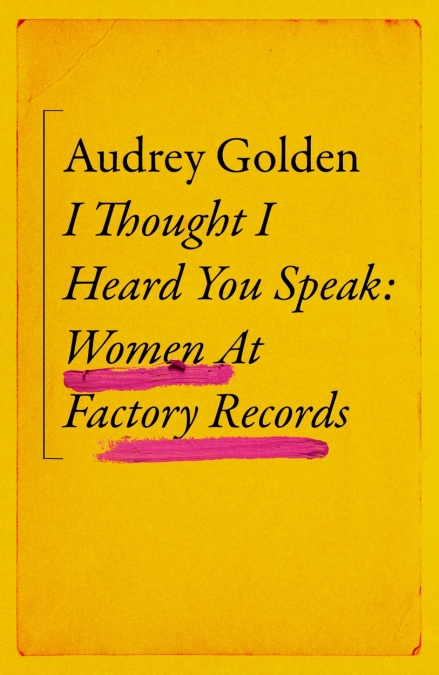
Why did you decide on the oral history format for I Thought I Heard You Speak? What are some of the challenges and benefits of doing an oral history?
I knew that book needed to be in an oral history format because of the stark exclusion of so many women’s voices from the history of Factory Records. I wanted their voices to be the thing in that book and to really shine — especially those women who did so much work to make that label work and weren’t even mentioned once by name, or were mentioned once in existing books and got their names misspelled.
You know, I originally wasn’t going to name him, but after some recent stuff, I feel like I really should. Can I do it here? I heard from one of the women I interviewed for that book (and who’s in the book), that she’d mentioned to James Nice she was interviewing with me, probably back in 2020 or 2021. She’d told him about my book and relayed to me that he’d replied with something to her like, “who’d want to read that book?” and I thought UGH. Up to that point, I’d loved reading his book on Factory, and loved knowing a lot of those stories. I’d hoped I Thought I Heard You Speak would be something that he and anyone else who’d written on Factory would see as this wonderful thing that enlivened the music history they loved so much, too. Anyway, on top of that comment, I saw Faber just reissued his Factory Records book, and in all the marketing and announcements, he’s doubling down on calling his book the “definitive history” of the label while adding stuff about how, essentially, everyone who is anyone agrees with that description. And people wonder how certain voices get marginalized from histories? It’s because of that insistence on the “definitive” label (as I’ve said a million times, I suspect, and in so many places, no history is EVER definitive), and the refusal of anyone to just own something and say “wow, can’t believe I missed some of these voices. So glad there’s something out there that really makes this history fuller!” Honestly, it only makes me want to break down all this male gatekeeping even more. For fuck’s sake. It bums me out, but I’m also not that surprised in the end. Sad about it, and demoralized, but not that surprised.
But let me also say a couple more good things about the oral history format and its challenges!!! Because this is also how I did a lot of the research for Shouting Out Loud. I knew I wasn’t going to write this book as an oral history (which Mojo got really wrong after reading it, which made me sad!) because there was a lot more research going into the book beyond those oral history interviews, but I also really wanted this to be a book with my narrative voice telling the story.
Oral history research can be really challenging because it can be REALLY difficult to track some people down, and it can be difficult to connect with people in interviews sometimes — no matter how much background research and work you do before the interview (so my advice about this is, give yourself a little grace if you’re doing this kind of research and an interview just doesn’t feel like it clicked, or that you got anything great out of it — it’s not always you!). And when you’re planning a book in an oral history format — like I Thought I Heard You Speak — you can feel a real need to get ALL of the voices you want in there, but if you can’t track someone down, or just can’t convince someone to speak, you can feel this sense of incompleteness. Ultimately, I think you’ve got to just live with that, and I like to provide a note about who I really wanted to talk with but couldn’t for whatever reason. One of the great joys of oral history work is that you become this interlocutor in the collation of a narrative and oral archive, even if it never leaves your own hard drive, and even if a lot of the material doesn’t end up in the book you’re writing. You become a collector of stories, and the histories alongside them, and I adore that aspect and find it really meaningful.

How did the political moment the Raincoats formed in shape their character?
So much, I think. They were thinking about the DIY rise of punk, the anti-racism and anti-sexism of the political moment in London (especially coinciding with Rock Against Racism and Rock Against Sexism), and I think they took all of that to heart and did something distinctive with it.
What are some classic Raincoats lessons we can apply to the current moment?
They saw that these converging moments (that I noted above) meant it was possible to truly make something your own way, and do it on your own terms. I love this quote Ana had when we were talking for the book, which I used in Shouting Out Loud, and it had to do with a fan coming up to her and Anne Wood at a 2010s show in Japan. The fan, a young girl, said she wanted to be like The Raincoats, and Anne essentially told her that you can be like The Raincoats by being yourself! What a great life lesson, and it reflects (to me) the line in “Fairytale,” that “no one teaches you how to live.” I wish I’d had that advice when I was a lot younger. I probably would have had a lot more self-confidence, and it wouldn’t have taken me until I was in my 40s to feel like I had a true sense of myself and what it means to really exist as yourself in the world. But I do now, I think. Thanks, Raincoats!

The Raincoats’ music seems like one element in their life’s work. They also show us that art is something you do into your older years, and many get better at it. Why do you think they have stayed relevant and what’s the secret to their longevity?
You know, I was just telling a friend something my grandmother said to me a few years before she died (and she lived a very long life in terms of years!). She said something like, “I always feel 25 yrs old when I’m just sitting here thinking, or watching something, and we all mostly do, until we try to stand up (she was having mobility issues at the time).” And, she added, “it all goes by like lightning.” What she meant, or at least how I took it, was that we don’t feel like older versions of ourselves (or oneself) at any given point in time. It’s still possible to have so many of the feelings we had a long time ago — sitting in an art classroom, and dreaming about the future, for example, or sitting in a park with a walkman while listening to Nirvana — time collapses in that way, and we still have access to the senses of wonder and possibility that are so characteristic of being young. I don’t know for sure about The Raincoats, but I think this is one of the things that makes it possible to feel like there’s no expiration date on creativity. And especially for women — that idea is such a product of a misogynist culture.
I think The Raincoats would also say that artists of varying generations becoming interested in their music has sort of re-catalyzed them, in turn, to come back to their own music and to want to make more art anew. They’re constantly inspiring, and being inspired — this circular process that’s really lovely to be able to track and to witness across time and space.
And, of course, in terms of the longevity of their music, there’s just absolutely NOTHING that’s tethered to a particular temporal moment in any of their songs or albums, and that is something that’s so amazing to me about their work. It feels like it could have been written at the same time the Fluxus artists started dipping into sonic expression, or just recorded yesterday. That’s one of the ways their music lives outside time (in addition to their intentionally arrhythmic time signatures), which is something that I really wanted to come across in Shouting Out Loud, and something that I think is so special about their music.

The Raincoats had their community in the UK in the early days but seemed to fit in with the NYC scene more when it comes to music. It seems like a common theme with women musicians of that era – they were not taken seriously even though they turned out to be legends. Why was that?
Yeah, as I hope anyone who reads Shouting Out Loud will see, there’s a really indelible connection between The Raincoats and NYC. Their sound fit in (not by being similar to sonically, but by having a similar experimental approach to) so many of the no wave bands coming out of the downtown scene at the time. And so many of those artists were women! And as to the women-musicians-not-being-taken-seriously, argh, it’s so true, and I think it’s so much a result of women just not being taken seriously in general. I think a lot of that is because the gatekeepers were men — and by gatekeepers, I mean the ones writing the music journalism, running labels, overseeing venues, etc etc. I talked to Vivien Goldman about this for Shouting Out Loud, and in more detail for a profile I just did of her for Gusher magazine, but she was among the only women in this crucial role. For the most part, I think, you just weren’t getting male music journalists and A&R guys (and yes, they were mostly guys) celebrating female artists. I think that’s changing a little, but not as much as it could. I mean, look at the data coming out from UCLA’s Gender in Popular Music project. Female-fronted bands are still few and far between on major festival lineups, at the controls in sound booths, and on. And the same goes for so many artists of color, and women of color. There are still a lot of gatekeepers with ideas that don’t seem to have progressed from the 1970s and 1980s, at least when it comes to a lot of music stuff that isn’t in indie spheres.
What is it about the word feminism that many people have a hard time with, even feminist trailblazers. Is there a different word we should use?
I think there are different issues surrounding its use. Within The Raincoats, the band members who didn’t want to explicitly call themselves feminist definitely shared a belief in female equality and power but didn’t want to be pigeonholed. There’s also the question about (or lack of) intersectionality that became prominent in riot grrrl communities, and that’s quite obviously a significant and salient point — the way the term feminism was imagined was often a very white one. Even if there wasn’t an intentional exclusion of women of color, there was often a de facto one in terms of issues addressed and the way in which a “feminist” was envisioned.
I go back and forth myself about how I think of the term, and I think there are pros and cons of its use (but NOT pros and cons to the idea that women, including women of color, are equal to men). I don’t know if there’s a better word for that… EqualRightsist doesn’t quite have the same ring to it! Sort of pathetic we have to even think about defining ourselves in ways that make clear we believe women are equal, but that is indeed where we (still) are, and perhaps more than we even were a couple of decades ago, in some ways given the current political situation in the US.

Since we are facing a democracy crisis in the U.S., tell us how the idea of democracy worked for the band.
I think, like a lot of bands, The Raincoats really wanted to be a democracy, and it was their ideal. But, in practice, nothing ever really quite works that way, right? There were shared ideas that were always brought to the group, and they shared royalties very equally and fairly — everything to do with money was absolutely equal, no matter who wrote a particular song or came up with the bass line or whatever — and that’s something that remains really important to them. But I think when you put several very strong-willed and powerful women together in a group, a true democracy isn’t necessarily possible. Ongoing friendship and compromise, certainly! But true democracy, probably not really in the end (but perhaps it’s true to say they came closer than many other bands trying to get there!).
Tell us a story you had to leave out of the book for whatever reason.
I learned from The Raincoats that Anton Fier (of The Feelies, Lounge Lizards, Pere Ubu, and more) had auditioned to be their drummer at one point in the early 80s. I’m a HUGE fan of The Feelies, so I wanted to explore this a lot more. It turned out it wasn’t something that had stuck in the memories of The Raincoats as much as other things had, and unfortunately, Anton Fier had already left this realm, so I couldn’t get in touch with him to hear more.

What part of NYC do you live in?
I actually live in the Hudson Valley now! I was one of the NYC departers during COVID. I honestly love living near a train and being pretty close to the city now but having a backyard with a garden, and more wall space to hang more art! I feel really lucky to live in such a cool old house where I can still have access to NYC in all the best ways.
What are you working on now? Any other books in the pipeline?
Yes! I have a book for Bloomsbury’s relatively new “Genre Series” coming out in the nearish future on QUEERCORE, which was a total dream to write. I turned that manuscript in not too long ago, so I’ve now completely immersed myself (research and writing-wise) in my next big project, which is a biography of Mark Lanegan. I’m doing oral history research for this one, too, but unlike other books I’ve written, I’m planning to really craft this one in the form of a novel for all kinds of reasons that are constantly running through my head.

What are you reading, watching, eating?
I’m one of those people who is always reading several different books at once, and in little spurts. I’ll go from one to another without finishing one, is what I mean. I’m currently revisiting Stefan Zweig’s The Royal Game, and I’m in the middle of Markus Werner’s The Frog in the Throat, Karen Russell’s The Antidote, and Nick Cave’s book of interviews with Seán O’Hagan. I’m also always going back to and reading new little portions of Walter Benjamin’s The Arcades Project, or rereading portions that I’d forgotten I’d read. There’s always something in there that brings meaning to me at some random moment.
Watching: I’m such a sucker for British detective shows, so that’s usually what I’m watching if I’m looking for something to interest me for a given 50 minutes or so! I especially love the detective shows with female leads.
I also recently watched Andrew Haigh’s film All of Us Strangers and loved it so intensely. And I also just saw The Ballad of Wallis Island, which warmed my heart like no other film has in recent memory — I loved it.
As for food, I’m always eating pasta and desserts… haha, maybe that doesn’t sound too great. I’m especially a sucker for really delicious pies.

Day jobs, pets, hobbies?
I work a regular 9-5 day job as an editor at Bard College. Writing books would be totally impossible, financially speaking, otherwise! I was on university faculty for a long time at a few different institutions, but I ultimately decided to leave academia in 2021 after a lot of careful thought, and I’m honestly really glad I did, although I miss teaching some of the great students I had over the years!
As for pets, I am a really ardent animal lover. Currently, we have three cats (two newly adopted 2-yr-old bonded siblings, Ozzy and Augustus Pablo, who are super sweet). Our third cat is Marguerite, a 13-yr-old weirdo, who we’ve had since she was a kitten, and who I love for who she is! I recently lost my sweetest boy, Matin, a 13-yr-old tabby cat who we’d also had since he was a kitten (some friends found him, along with his sister Marguerite, in pretty bad shape in the woods, and we rescued them). He was the best animal, and I miss him every day, honestly. I’ve also had and fostered dogs in the past, and I’m constantly pestering my partner about adopting another dog (he’s sort of agreed to move forward with that plan in January, after my book travel settles down). I’ve also been trying to convince a couple of local farmers to let me “invest” in two sheep on their farm (meaning, basically, I’d have two sheep of my own at their farm). I’d honestly have a whole menagerie of rescue creatures if I had the space and finances to do it.
And hobbies! I’m a book and art and record collector, and I play a lot of music in my spare time. I also love fashion design and try to work on my own clothes when I find cool new textiles, or something at a thrift store I can dye and repurpose.
Upcoming book events for Shouting Out Loud:
- July 17, Seattle, Hex Enduction Books and Records, 6pm (part of Art Walk, and there will be a singalong!)
- July 18, Portland OR, Powell’s, with Gail O’Hara, Corin Tucker, and Sheri Hood, 7pm
- July 25, NYC, Rough Trade NYC, with Evan “Funk” Davies of WFMU, 6pm
- July 31, North Adams MA, Mass MoCA, 5pm
- August 30, Dorset UK, End of the Road Festival, In-convo with Gina Birch, 10:30am, signing 12pm
- August 31, Bristol UK, Rough Trade Bristol, with Ana Calderon of Digital Resistance, 5pm
- September 3, Glasgow UK, Glad Cafe, with The Raincoats, 7pm
- September 6, London UK, Rough Trade East, with The Raincoats, 7pm
- October 14, Porto PT, Termita bookstore, with Ana da Silva
- October 18, Lisbon PT, Well Read Lisbon, with Ana da Silva
- TBD:
- Los Angeles
- Boston
Records Audrey cannot live without
- New Order, Power, Corruption & Lies
- Ramones, Rocket to Russia
- Hole, Live Through This
- Townes Van Zandt, Live at the Old Quarter
- Leonard Cohen, Songs from a Room
- Magnetic Fields, 69 Love Songs
- The Feelies, Crazy Rhythms
- Mark Lanegan, Whiskey for the Holy Ghost
- The Raincoats, Odyshape
- Bikini Kill, Pussy Whipped
- Nirvana, Unplugged in New York
- Velvet Underground, Loaded
- Team Dresch, Personal Best
- Bob Dylan, Blood on the Tracks


